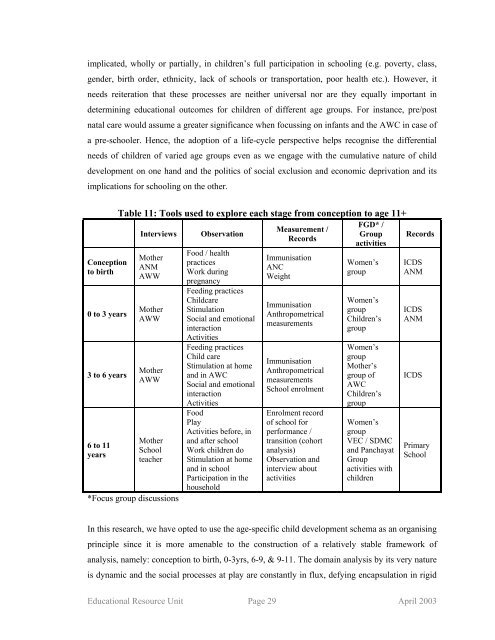Snakes and Ladders - ERU Consultants Pvt. Ltd.
Snakes and Ladders - ERU Consultants Pvt. Ltd.
Snakes and Ladders - ERU Consultants Pvt. Ltd.
You also want an ePaper? Increase the reach of your titles
YUMPU automatically turns print PDFs into web optimized ePapers that Google loves.
implicated, wholly or partially, in children’s full participation in schooling (e.g. poverty, class,<br />
gender, birth order, ethnicity, lack of schools or transportation, poor health etc.). However, it<br />
needs reiteration that these processes are neither universal nor are they equally important in<br />
determining educational outcomes for children of different age groups. For instance, pre/post<br />
natal care would assume a greater significance when focussing on infants <strong>and</strong> the AWC in case of<br />
a pre-schooler. Hence, the adoption of a life-cycle perspective helps recognise the differential<br />
needs of children of varied age groups even as we engage with the cumulative nature of child<br />
development on one h<strong>and</strong> <strong>and</strong> the politics of social exclusion <strong>and</strong> economic deprivation <strong>and</strong> its<br />
implications for schooling on the other.<br />
Conception<br />
to birth<br />
0 to 3 years<br />
3 to 6 years<br />
6 to 11<br />
years<br />
Table 11: Tools used to explore each stage from conception to age 11+<br />
Interviews Observation<br />
Mother<br />
ANM<br />
AWW<br />
Mother<br />
AWW<br />
Mother<br />
AWW<br />
Mother<br />
School<br />
teacher<br />
*Focus group discussions<br />
Food / health<br />
practices<br />
Work during<br />
pregnancy<br />
Feeding practices<br />
Childcare<br />
Stimulation<br />
Social <strong>and</strong> emotional<br />
interaction<br />
Activities<br />
Feeding practices<br />
Child care<br />
Stimulation at home<br />
<strong>and</strong> in AWC<br />
Social <strong>and</strong> emotional<br />
interaction<br />
Activities<br />
Food<br />
Play<br />
Activities before, in<br />
<strong>and</strong> after school<br />
Work children do<br />
Stimulation at home<br />
<strong>and</strong> in school<br />
Participation in the<br />
household<br />
Measurement /<br />
Records<br />
Immunisation<br />
ANC<br />
Weight<br />
Immunisation<br />
Anthropometrical<br />
measurements<br />
Immunisation<br />
Anthropometrical<br />
measurements<br />
School enrolment<br />
Enrolment record<br />
of school for<br />
performance /<br />
transition (cohort<br />
analysis)<br />
Observation <strong>and</strong><br />
interview about<br />
activities<br />
FGD* /<br />
Group<br />
activities<br />
Women’s<br />
group<br />
Women’s<br />
group<br />
Children’s<br />
group<br />
Women’s<br />
group<br />
Mother’s<br />
group of<br />
AWC<br />
Children’s<br />
group<br />
Women’s<br />
group<br />
VEC / SDMC<br />
<strong>and</strong> Panchayat<br />
Group<br />
activities with<br />
children<br />
Records<br />
ICDS<br />
ANM<br />
ICDS<br />
ANM<br />
ICDS<br />
Primary<br />
School<br />
In this research, we have opted to use the age-specific child development schema as an organising<br />
principle since it is more amenable to the construction of a relatively stable framework of<br />
analysis, namely: conception to birth, 0-3yrs, 6-9, & 9-11. The domain analysis by its very nature<br />
is dynamic <strong>and</strong> the social processes at play are constantly in flux, defying encapsulation in rigid<br />
Educational Resource Unit Page 29 April 2003












